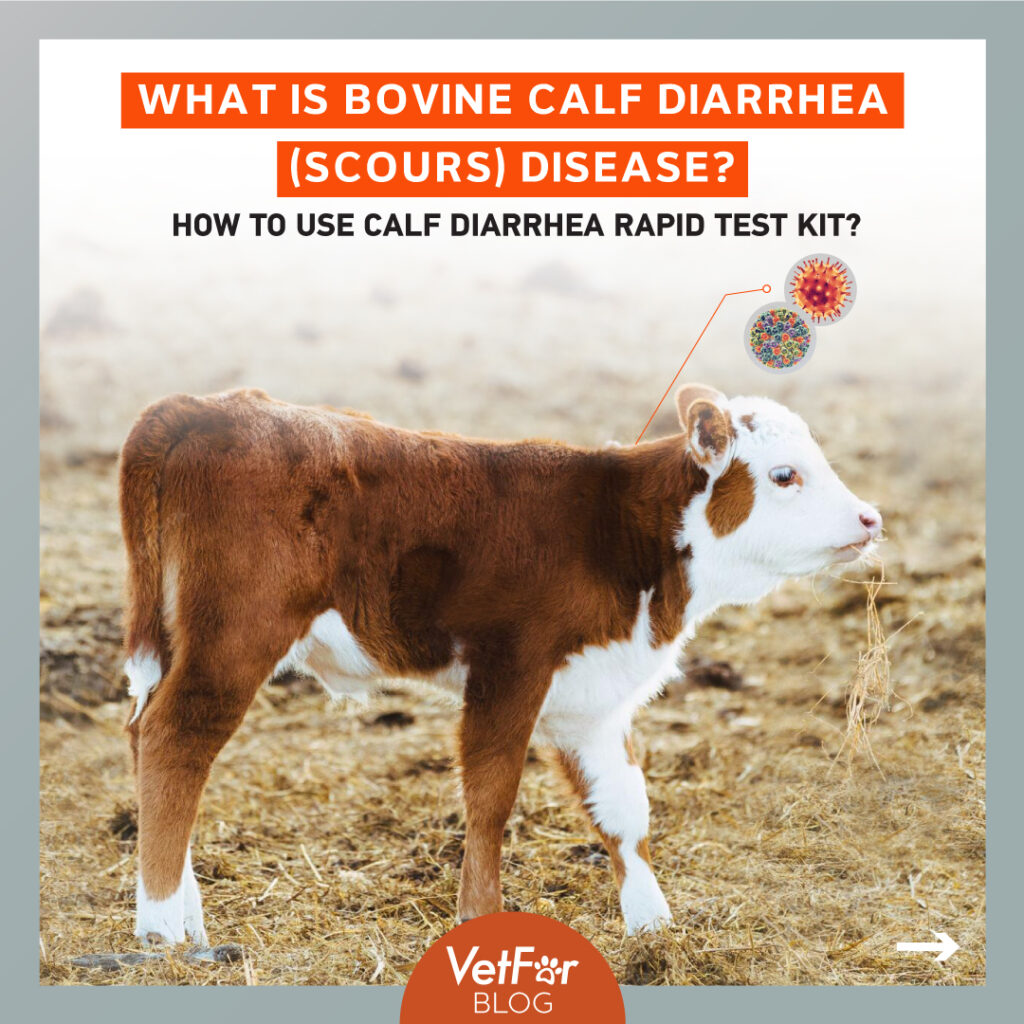Bovine Calf Diarrhea, commonly known as Scours, is a prevalent and potentially serious health issue affecting young calves in the cattle industry. This disease can have significant economic and animal welfare implications, making it essential for farmers and ranchers to understand its causes, symptoms, and prevention strategies. In this blog, we will delve into the details of Bovine Calf Diarrhea, shedding light on the factors contributing to its occurrence and how to manage and prevent it effectively and Calf Diarrhea Rapid Test Kit.
Understanding Bovine Calf Diarrhea
Bovine Calf Diarrhea, or Scours, is a gastrointestinal disease that primarily affects calves within the first few weeks of life [1]. It is characterized by severe diarrhea, dehydration, and, in severe cases, can lead to death if left untreated [1]. The disease can be caused by various factors, which can be broadly categorized into infectious and non-infectious causes.
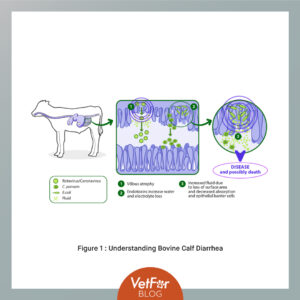
Infectious Causes:
- Bacterial Infections: Bacteria like Escherichia coli (E. coli), Salmonella, and Clostridium perfringens are common culprits behind calf diarrhea [2]. These pathogens can infect the calf’s intestines, causing inflammation and leading to diarrhea.
- Viral Infections: Viruses, such as Rotavirus and Coronavirus, can also trigger calf diarrhea [2]. These infections are highly contagious and can spread rapidly among a group of calves.
- Parasitic Infections: Internal parasites, such as Cryptosporidium and Giardia, can infect the gastrointestinal tract of calves, causing diarrhea [2].
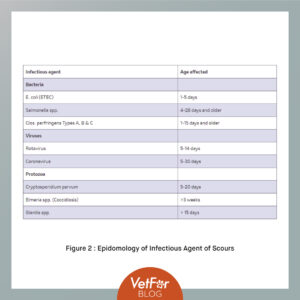
Non-Infectious Causes:
- Stress: Calves are particularly susceptible to stress during the neonatal period. Stressors like abrupt weaning, transportation, or adverse environmental conditions can weaken their immune system and make them more prone to diarrhea [3].
- Poor Nutrition: Inadequate colostrum intake or an unbalanced diet can compromise the calf’s health and increase the risk of diarrhea.
- Environmental Factors: Contaminated water, feed, or bedding can introduce pathogens to the calf’s environment, increasing the likelihood of infection.
Symptoms of Bovine Calf Diarrhea
Recognizing the early signs of Bovine Calf Diarrhea is crucial for effective management and treatment. Common symptoms include:
- Watery, foul-smelling diarrhea: Calves with Scours typically have loose, watery stools that may contain blood or mucus [3].
- Dehydration: Diarrhea can lead to severe fluid loss, causing dehydration. Affected calves may appear lethargic and have sunken eyes [3].
- Loss of appetite: Calves with diarrhea often lose interest in feeding, leading to weight loss and weakness.
- Fever: An elevated body temperature may accompany the disease.
- Isolation: Infected calves may separate themselves from the herd and appear generally unwell.
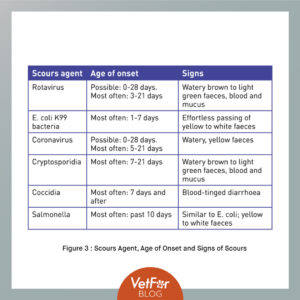
Prevention and Management
Preventing Bovine Calf Diarrhea is more cost-effective and humane than treating the disease once it occurs. Here are some strategies to help minimize the risk:
- Colostrum management: Ensure that calves receive an adequate amount of high-quality colostrum in their first hours of life to boost their immune system.
- Hygiene: Maintain clean and sanitized feeding equipment, housing, and water sources to prevent pathogen transmission.
- Vaccination: Consult with a veterinarian to develop a vaccination strategy based on local disease prevalence and risk factors.
- Nutrition: Provide a well-balanced diet that meets the specific needs of growing calves.
- Stress reduction: Minimize stress factors by implementing proper management practices and avoiding abrupt changes in the calf’s environment.
- Regular monitoring: Keep a close eye on the health of calves, especially during the critical neonatal period. Early detection can help prevent the disease from spreading.
Treatment of Bovine Calf Diarrhea
Effective treatment of Bovine Calf Diarrhea is crucial for the calf’s health and well-being. The treatment may include:
- Rehydration: Dehydration is a significant concern, so providing oral or intravenous fluids is essential. Oral electrolyte solutions specially designed for calves can help replace lost fluids and electrolytes.
- Antibiotics: In cases where bacterial infections are suspected, a veterinarian may prescribe antibiotics to combat the bacterial pathogens responsible for the diarrhea.
- Nutrition: Ensuring that the calf continues to receive proper nutrition is crucial. Feeding a balanced diet and, if necessary, adjusting the diet to accommodate their needs during recovery is important.
- Isolation: Infected calves should be isolated from the healthy herd to prevent the spread of the disease.
- Environmental Management: Improving hygiene in the calf’s living environment can reduce the risk of reinfection and support the recovery process.
- Consulting a Veterinarian: Always consult with a veterinarian to determine the appropriate course of treatment and to rule out any underlying health issues.
Diagnosis of Bovine Calf Diarrhea
Accurate diagnosis is crucial for effective treatment and management of Bovine Calf Diarrhea. Diagnosis methods include:
- Clinical Examination: Veterinarians perform a physical examination of the calf to assess its overall health. They look for clinical signs such as diarrhea, dehydration, fever, and loss of appetite.
- Fecal Analysis: A microscopic examination of the calf’s feces can identify the presence of parasites or abnormal bacteria. This helps determine if the diarrhea is infectious in nature.
- Blood Tests: Blood samples can provide valuable information about the calf’s overall health and may help identify any systemic issues, such as electrolyte imbalances.
- Pathogen Detection: In some cases, diagnostic tests may identify specific pathogens responsible for the diarrhea. This can be done through polymerase chain reaction (PCR) testing or culturing samples [4].
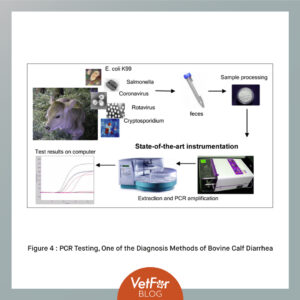
- Serological Tests (ELISA): Enzyme-linked immunosorbent assay (ELISA) is a serological test that can detect antibodies or antigens related to specific pathogens in the calf’s blood [4]. ELISA tests can be used to identify the presence of antibodies to particular pathogens, aiding in diagnosis.
- Rapid Test Kits: Rapid test kits are often used to detect specific pathogens quickly. These kits provide rapid results and can be particularly useful in diagnosing viral infections.
- Clinical History: A detailed history of the calf, including its diet, vaccination status, and any recent stressors, can provide vital clues for diagnosis.
How to Use a Calf Diarrhea Rapid Test Kit
Rapid test kits are convenient tools for quick and accurate diagnosis of Bovine Calf Diarrhea. Here’s how to use them:
- Step 1: Gather the kit and materials. Ensure you have the Calf Diarrhea Rapid Test Kit, gloves, and a clean, well-lit workspace.
- Step 2: Prepare the sample. Collect a fresh fecal sample from the affected calf. Use a clean, disposable glove to prevent contamination.
- Step 3: Follow the kit instructions. Each rapid test kit comes with specific instructions. Follow them carefully, as the procedure may vary slightly between different kits.
- Step 4: Apply the sample to the test device. Typically, you’ll place a small amount of the fecal sample onto the designated area of the test kit.
- Step 5: Wait for results. Rapid test kits provide results within a short time, usually within 15-20 minutes. Be patient and avoid any interference during this time.
- Step 6: Interpret the results. Check the test kit for clear indicators of a positive or negative result. The presence or absence of specific antibodies or antigens related to the disease will be indicated.
- Step 7: Consult with a veterinarian. If the results are positive or if you have any doubts about the interpretation, consult with a veterinarian for further guidance and treatment recommendations.
The Most Effective and Commonly Used Rapid Test Kits for Bovine Calf Diarrhea (Scours) Disease?
The 4in1 Calf Diarrhea Test Kit
The 4in1 Calf Diarrhea Test Kit also referred to as the Giardia lamblia-Cryptosporidium-Rotavirus-Coronavirus Antigen Combo Test Kit, is a specialized diagnostic tool. It is designed for the simultaneous qualitative detection of antigens associated with four prominent pathogens frequently found in bovine fecal samples: Giardia lamblia, Cryptosporidium, Rotavirus, and Coronavirus. These pathogens are often responsible for calf diarrhea, a condition that can result in significant health issues and economic losses within the cattle industry. This comprehensive test kit offers a convenient and efficient means to diagnose these pathogens, allowing for prompt intervention and treatment. Ultimately, it plays a pivotal role in safeguarding calf health and the overall well-being of the herd.
The 5in1 Calf Diarrhea Test Kit
The 5in1 Calf Diarrhea Test Kit is a highly valuable diagnostic tool designed for the rapid and qualitative detection of specific antigens associated with five significant pathogens in bovine fecal samples. These pathogens, which include Rotavirus, Coronavirus, Escherichia coli (E. coli) K99, Cryptosporidium parvum, and Giardia spp., are known to induce symptoms such as apathy, loss of appetite, diarrhea, dehydration, and fever in cattle.
In cases where these diseases manifest, especially among unvaccinated, immunocompromised, or young animals, they can lead to considerable levels of mortality. Given that the clinical signs and symptoms of these diseases often overlap, combination tests are recommended to accurately diagnose and differentiate between them. The 5in1 Calf Diarrhea Test Kit offers a rapid, precise, and cost-effective means of supporting veterinary professionals in the differential diagnosis of these infections. By facilitating early detection and distinguishing the causative agents, this kit contributes significantly to the prevention of onward disease transmission and the reduction of losses within the herd.
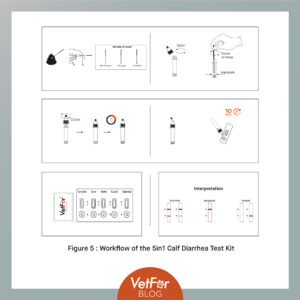
The 6in1 Calf Diarrhea Test Kit
The 6in1 Calf Diarrhea Test Kit is a groundbreaking diagnostic tool that provides an efficient and comprehensive solution for cattle farmers and veterinarians. This innovative kit allows for the simultaneous detection of six different pathogens—Rotavirus, Coronavirus, Escherichia coli (E. coli) K99, Cryptosporidium parvum, Giardia spp., and Clostridium perfringens—with just one fecal sample. Its primary advantages include aiding in early diagnosis, thanks to high rates of sensitivity, and a remarkably straightforward testing procedure. By offering a holistic approach to identifying the causes of Bovine Calf Diarrhea, this test kit plays a pivotal role in the timely treatment and containment of the disease. It is a vital resource for the management of calf health and the prevention of disease spread within the herd, ultimately contributing to improved animal welfare and farm productivity.
REFERENCES
[1] Cho, Y. I., & Yoon, K. J. (2014). An overview of calf diarrhea-infectious etiology, diagnosis, and intervention. Journal of veterinary science, 15(1), 1-17.
[2] Muktar, Y., Mamo, G., Tesfaye, B., & Belina, D. (2015). A review on major bacterial causes of calf diarrhea and its diagnostic method. Journal of Veterinary Medicine and Animal Health, 7(5), 173-185.
[3] Constable, P. D. (2009). Treatment of calf diarrhea: antimicrobial and ancillary treatments. Veterinary Clinics of North America: Food Animal Practice, 25(1), 101-120.
[4] Hamedian-Asl, M., Zakian, A., Azimpour, S., Davoodi, F., & Kahroba, H. (2022). Evaluation of diagnostic methods for the Detection of Bovine Coronavirus and Rotavirus in feces of diarrheic calves. Journal of the Hellenic Veterinary Medical Society, 73(2), 3951-3960.
